The Coleford Branch
Monmouth - Newland
- Coleford
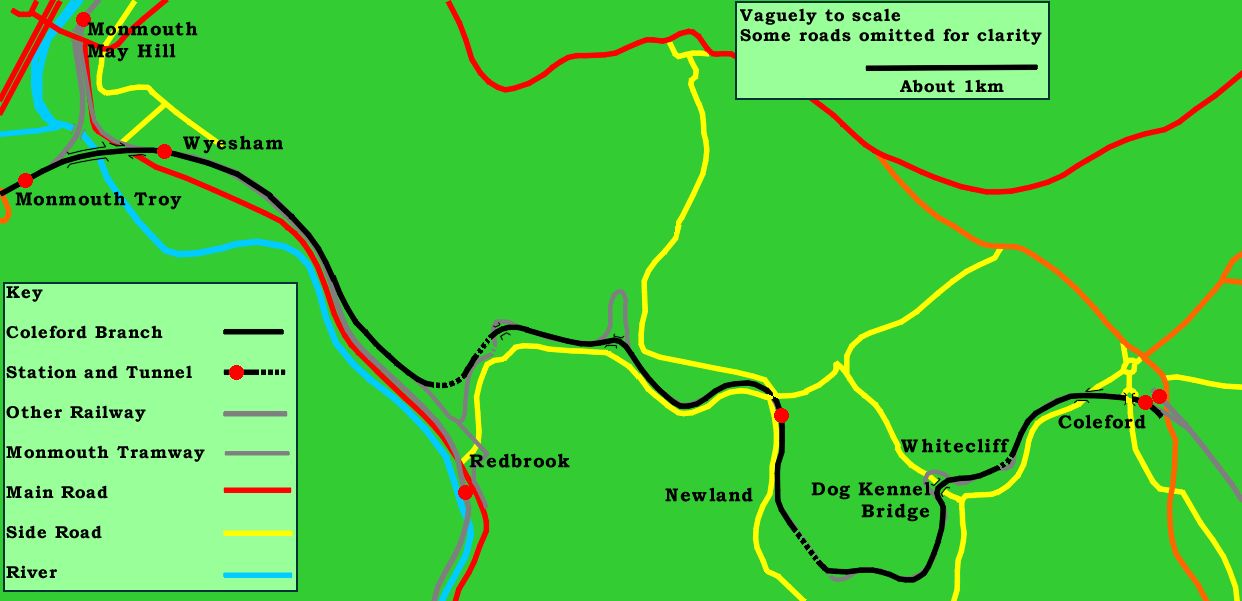
The Monmouth Tramroad, linking
Monmouth with Coleford and opening in 1810, launched rail transport
in the area with some success. For 47 years it was Monmouth's
only rail link. Originally it was to be the centrepiece of a
sizeable network, not all of which was built, and was probably
mostly notable for its long tunnel near Newland and the mention
in the Act of Parliament of passenger traffic - said to be the
first time that a railway of any kind had suggested in its Act
that it would make money by carrying passengers.
The second rail link - which
was the first "proper" railway - arrived from Pontypool
in 1857 with grand plans of converting the tramway into a railway,
capable of handling locomotives producing more than 1hp and hauling
more than one wagon. It was the Coleford, Monmouth, Usk and Pontypool
Railway - a reduced version of the earlier Dean Forest, Monmouth,
Usk and Pontypool Railway, which had flopped in 1845, but which
was now back with plans to rebuild the tramway as a full-scale
railway.
But the tramway proved resilient.
Monmouth Troy station, terminus of the line from Pontypool, was
on the opposite bank of the Wye and it took another four years
for the railway to span the gap with an impressive viaduct. This
viaduct made up most of the extension to Wyesham Wharf; it must
have been one of the most expensive sidings, foot for foot, ever
built. Goods for Coleford were "transshipped" and loaded
onto tramway wagons which then headed off on the long slog up
to Coleford. The tramway also descended around the hillside to
the road bridge across the Wye into Monmouth proper, where a
wharf allowed goods to be unloaded into waiting river barges.
The barges were largely rendered
obsolete by the rail link to Pontypool and even the ex-Coleford
produce which was still bound for Chepstow found it quicker to
go by train than travel down the Wye. Thus there were few problems
in converting May Hill Wharf into Monmouth May Hill station when
the railway from Ross turned up in 1873. An alternative, straighter
and easier link into the Forest of Dean via the Ross and Monmouth
Railway and the Severn and Wye Railway's Lydbrook Branch opened
in 1875. The direct link to Chepstow was resurrected by the Wye
Valley Railway in 1876, at which point use of the tramway to
Monmouth ceased. The Great Western Railway, by now owner of the
Monmouth to Pontypool line, began drawing up plans for its replacement.
In 1883 the newer and more
heavily engineered Coleford Branch was opened along roughly the
same route, with the tramway being finally axed at the same time
after 73 years. It had opened before the Industrial Revolution
got going and was replaced as the Revolution petered out; its
steeply-graded and curvaceous route laid out in a bygone era
was made more apparent by the larger trains working up it at
a maximum speed of 20 miles per hour. The link between Wyesham
Wharf and Monmouth May Hill was abandoned and disappeared. The
tramway had once continued from Coleford down the other side
of the hill to Parkend in the Forest of Dean, but that route
had been converted into the Severn and Wye's Coleford Branch
some years previously. The result had been the loss of the direct
run from the Forest to the River Wye, which failed to be re-instated
with the opening of the Great Western's branch. Instead the new
brick station building and goods shed on the Monmouth line gazed
across the station area at the Severn and Wye's tumbledown timber
station building and goods shed. If you wanted to get a wagon
from one goods yard to the other you had to take it via Monmouth
and Lydbrook.
This final effort to boost
Forest industries by improving the outlet to South Welsh industry
may have succeeded briefly - although, given that it wasn't an
outlet from the Forest to Wales but a branch from Monmouth to
Coleford, it was probably always a failure. Services were always
slow and worked as "mixed trains" with passenger stock
and goods wagons in one formation. By the time the First World
War broke out the only traffic which was vaguely prospering was
stone from Whitecliff Quarry, near Coleford, so a link was provided
between the Severn and Wye and Great Western lines at Coleford
and the line between Whitecliff and Monmouth was closed from
the beginning of 1917, lifted and despatched to France for the
war effort.
Although officially only temporarily
closed, the Coleford Branch ultimately turned out to be one of
50 or so minor lines which the First World War killed for good.
The link to Whitecliff survived for a further 50 years and it
became the second of Monmouth's railways to shut entirely in
1967. The trackbed is now isolated with no rail connections at
either end and divided between several owners. At Coleford the
goods shed survives but the line's other buildings have largely
gone and bits of the route have been built over. At the current
time, reopening looks rather unlikely. However, the railway is
the subject of a roughly annual walk by the Welsh Railways Research
Circle and it was on the third one of these trips that most of
these pictures were taken - hence, unusually for us, they have
people in them occasionally. Coleford's goods shed is now a museum
on the Forest of Dean's rail network, with an imported signal
box, engine shed, miniature railway and a few items of standard-gauge
stock.
Although most of the route
closed in 1917, its Engineer's Line Reference - once "COL"
but now "CFG" - counts milepost 0 as being at Wyesham
Junction. (The reference is still required for noting maintenance
requirements for the large numbers of structures along the route
which have spent the last 90-odd years earning nothing and costing
a fortune to maintain.) This is actually a fairly new development
- the GWR plans of the Wye Valley and Coleford lines have Wyesham
Junction at milepost 68 and continue counting from there up to
Coleford, so Newland, for example, is 70¾ miles from somewhere.
With Pontypool only being 17 miles away and Newport 30 miles
away, the exact location of the Coleford Branch's old milepost
0 is a mystery.
All pictures on this page
taken in 2008.
|
Monmouth Troy
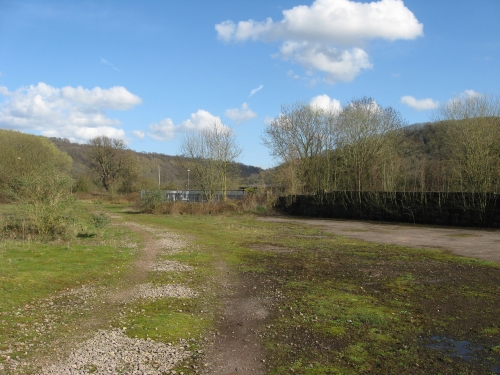
|
Monmouth Troy spent 33 years
with the unusual accolade of being the centre of four branchlines
- and often acting as the terminus for all of them. The Coleford
Branch was the last to arrive and the first to go, so most pictures
of the station record it as the centrepoint of the three surviving
lines (until 1955), the common terminus of two minor branches
(1955-9) or the rather vacant northern goods yard of a solitary
rural freight-only branch (1959-64).
The short stay of the Coleford
Branch means that it never made much of a mark on the station
- although, on the whole, Troy retained a bit of a feeling of
a joint station separate from its railways and none of them got
preferential treatment. The Monmouth Tramroad went to May Hill
rather than Troy. Consequently this station cannot be said to
really feature much in the history of Coleford's railways - or
Coleford's railways feature much in the history of this station.
This is the view from the
surviving bit of the goods yard. The platforms are off to the
right, the gas station parked on the railway station throat is
the grey blot in the centre and Coleford Branch trains vanished
off to the left. |
|
Wyesham Wharf
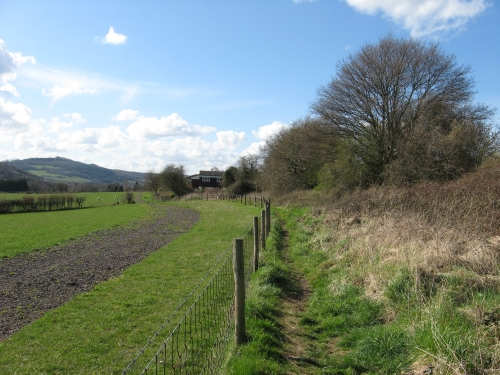
|
Wyesham has had three suffixes
for its railway operations over the years. Wyesham Wharf was
created when the Coleford, Monmouth, Usk and Pontypool Railway
reached here in 1861 (the closest to Coleford that the Company
would ever get) and set up a transshipment point. No photos or
plans seem to readily exist (although there should be a plan
out there somewhere) but it will probably have consisted of a
platform with the tramway and a couple of loops on it and a railway
line with a couple of loops and sidings running alongside the
platform.
Passenger trains reached Wyesham
when it became Wyesham Junction in 1876 with the opening of the
line from Chepstow. It was not the traditional junction where
one line diverged from another but an "end on" junction
where the new line simply joined onto the end of the older one
and the bufferstop was removed. It became a traditional junction
in 1883 when the tramway was replaced with the Coleford Branch.
This picture is from the WVR's trackbed and the Coleford Branch
rose away towards Coleford to the right of the bramble bushes.
Much of the junction and the railway into Monmouth has now been
squashed by the houses in the distance.
The junction closed in 1917,
with the signal box - once sat in the middle of the bank of trees
- being formally abolished in 1922 and subsequently removed.
Wyesham returned to the railway map when Wyesham Halt opened
in 1931 at the Monmouth, or other, end of the site and this was
served by Chepstow trains until Monmouth's passenger services
ceased in 1959. |
|
Redbrook Tunnels
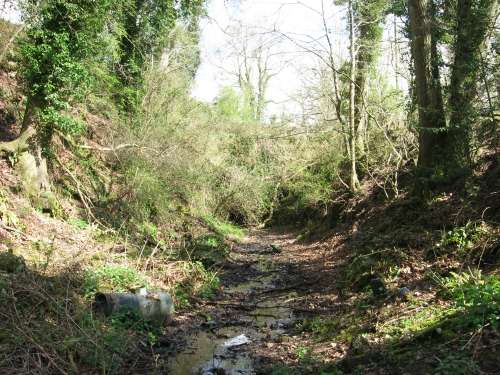
|
There were two tunnels above
Redbrook - the shorter Upper tunnel and the longer Lower tunnel
(which are not to be confused with the villages of Upper and
Lower Redbrook). The Lower tunnel replaced a loop around the
end of the ridge above Redbrook, cutting through the hill instead.
The loop and linked into a steeply-descending rope-worked incline
into the centre of Redbrook, which wasn't really compatible with
the modern railway and, anyway, had been pretty much rendered
obsolete by the arrival of the Wye Valley Railway and the provision
of its goods facilities in Redbrook 7 years earlier. So both
loop and incline bit the dust; the incline and its bridge over
the road between Newland and Redbrook remain clearly visible,
but the loop has faded out in the sort of way that minor infrastructure
works abandoned 126 years ago fade out.
The Upper Redbrook Tunnel
is shown in this picture at the end of the cutting leading to
its open Monmouth portal, which is behind a tree (do remember
that this cutting was last used in 1917). It replaced another
slightly longer loop on the tramway, although that loop ran through
its own lower and shorter tunnel a few yards away off to the
right. The tramway tunnel's Monmouth portal is open but now hidden
behind a garage, while the Coleford portal has been covered over
by the rather large back garden of a nearby house. The Upper
tunnel's Coleford portal, being somewhat bigger, has only had
its bottom six feet buried beneath the nicely-landscaped back
garden.
The Lower Tunnel was securely
sealed up after closure with full-height brick walls and used
for missile storage. It is not really easy to get inside, although
some people have, generally taking the opportunity to dump large
quantities of rubbish inside (largely expanded polystyrene, oddly). |
|
Newland
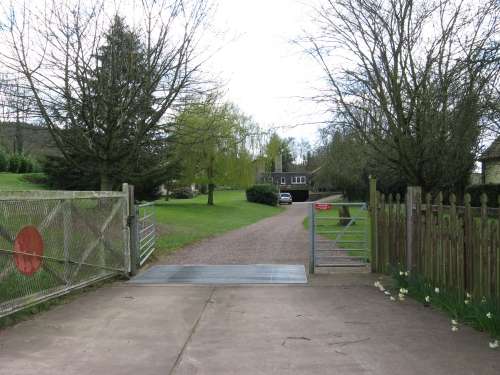
|
Newland station was the only
intermediate stop on the branch and was located next to the only
intermediate level crossing. It had two platforms and a small
goods yard, controlled by a signal box which stood on the left
of this photograph, which was taken from the site of the level
crossing (hence the design of the gate on the left).
The village of Newland is
a little distance away - the railway actually gets much closer
that this, but the territory there is not as flat. There were
also benefits to having the station at a road junction - mainly
that some additional traffic might come from the surrounding
area and one signal box could control the station and the level
crossing. The village features the "Cathedral of the Forest",
also known as Newland Parish Church, and the "Ostrich"
pub, which does pretty good food.
Newland was one of three stations
on the Monmouth network to be killed on the 1st of January 1917
- the other two being Coleford (GWR) and Tidenham (WVR) - and
the village was the only one on the Monmouth rail network to
be left without services after the end of the war. The nearby
tunnel was used for growing mushrooms and the station remained
intact, being used by the Army while it awaited the return of
services. It featured in a 1927 issue of The Railway Magazine
with a picture of the then-rare idea of a station without tracks,
where it was confusingly called Redbrook. But the trains never
came back and in the 1970s the station was partially demolished,
losing its signal box and becoming a private house. It remains
that way today. |
|
Dog Kennel Bridge
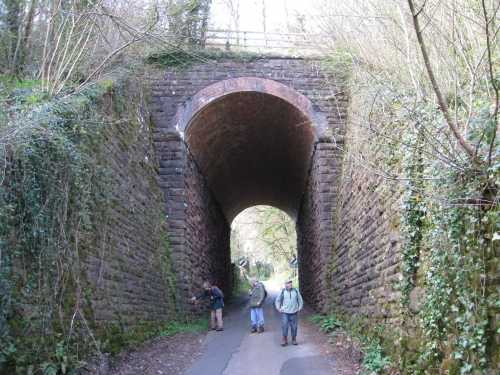
|
The curiously-named Dog Kennel
Bridge really has to be seen to be believed. The original tramway
bridge was a low timber girder on stone abutments crossing a
minor road serving a couple of farmsteads. This created a large
loop up this side valley, which initial plans for the railway
involved amputating and replacing with a gently curving viaduct.
Viaducts are expensive, however,
and taking a straight course means going a shorter distance and
consequently trains would have to climb more steeply. So the
viaduct was dropped from the plans and replaced by a huge embankment
which made a smaller loop up the side valley. Stuck through this
embankment was the new bridge for the minor road. Although it
is a rather large structure (particularly by single arch standards),
the top of the arch is still well below the top of the embankement,
which carried a minor single track railway. It now carries an
overgrown trackbed which is about the same width as the road
below. The railway was built to last and, 92 years after the
last train to Monmouth from Coleford, the Dog Kennel Bridge remains
in excellent condition. |
|
Whitecliff Tunnel
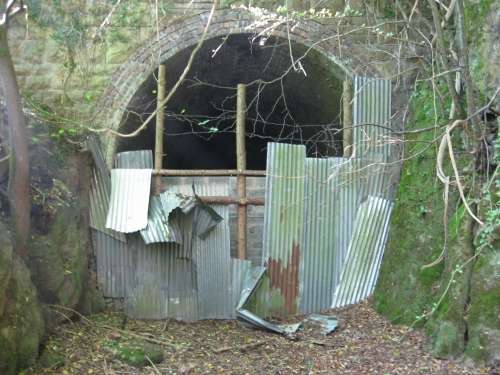
|
Whitecliff Quarry kept the
top end of the line open for five decades after closure overtook
the bulk of the route in 1917. A convenient moment to ask the
current owners of the (now closed) quarry if we can pop in and
take some pictures has not yet arisen, so this picture of the
longest-lasting of the line's four tunnels - Whitecliff Tunnel
- will have to do. This is the Coleford portal of the tunnel.
The quarry traffic left Coleford
for the rest of the world via the Severn and Wye Railway. The
track layout at Coleford kept train lengths down to no more than
8 wagons - rather screwing up any claims to mass transport -
although this was fine by locomotive crews, since it meant that
they only had to work 8 wagon trains down the nasty banks and
round the tight bends of the Severn and Wye's Coleford Branch.
The junction with the Severn and Wye mainline was called Coleford
Junction, not to be confused with the Coleford Junction on the
Exeter to Barnstaple line, and was located on the northern outskirts
of Parkend. The original tramway had descended steeply through
Parkend to point southwards and head down to the docks and mainline
at Lydney. This "steeply" was too steep for a railway,
so a four-foot high step was put into the tramway for a few years
to act as a transshippment point and called Marsh Sidings. Coleford
Junction eased the gradients by being half a mile further up
the mainline and pointing north, so once trains had descended
from Parkend locomotives had to run around again before they
could head south to Lydney.
This took a while, so the
Coleford Branches were shut in 1967 and for nine years the stone
was taken to Marsh Sidings by road. After 1976 the rail link
was cut out altogether and remains of the Severn and Wye line
closed. It is now preserved by the Dean Forest Railway.
Whitecliff Tunnel's Coleford
portal is now sealed up in this rather original manner. The Monmouth
portal is on quarry land and so remains open, albeit inaccessible. |
|
Coleford
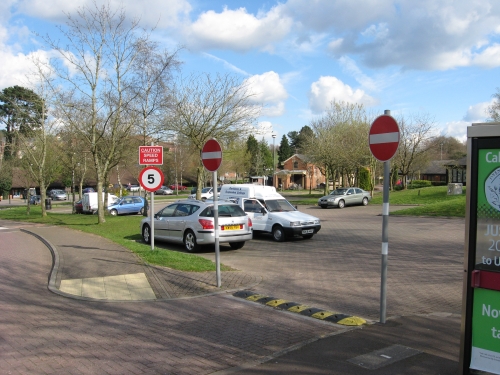
|
Coleford was once one of the
smallest towns to claim the accolade of having two stations -
and not just two stations, but two complete sets of facilities
conveniently situated for the town centre and slap bang next
to each other. The Severn and Wye station was off to the far
left, with trains heading out behind the brick building in the
distance and gently uphill for half a mile before descending
steeply towards Parkend at a ruling gradient of 1-in-29. The
brick building is the former Great Western goods shed; its station
filled the gap between there and the camera, before passing beneath
the road on which the photographer is standing just to the right
of the phone box and descending to Monmouth.
In later years the Severn
and Wye Railway passed into the hands of the Great Western and
Midland Railway companies and became a "joint" railway.
No use was made of this opportunity to connect the two networks,
concentrate all workings on the Great Western's newer (and larger)
buildings or inaugrate through trains between Cinderford, at
the north-eastern extremity of the Severn and Wye network, and
Pontypool. After closure of the Great Western's line its station
building remained intact, slowly decaying but surviving until
the cessation of all trains to Coleford. Meanwhile the Severn
and Wye's timber building decayed and in 1922 was burned to the
ground. It was subsequently replaced with a brick building, which
remained in use until passenger trains to Coleford were withdrawn
due to inadequate passenger numbers (about 8 per train) in 1929.
It also remained derelict into the 1960s. Although divided in
life, Coleford's stations are now united and equal in death -
except for the GWR goods shed which, as mentioned above, is now
a museum.
Curiously in nearby Cinderford
the Great Western and Severn and Wye came to an agreement and
built a joint station. In Cinderford the GWR's passenger services
outlasted the Severn and Wye's by 30 years and were finally axed
in 1959. Whether the hatchet-burying had any effect is another
matter. |
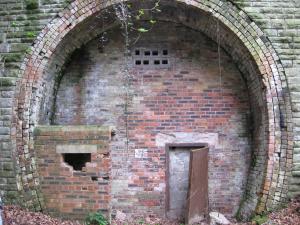
|
The background image shows
the south portal of Newland Tunnel. It was so securely sealed
that even the access door was bricked up (though a nice secure
locked door has since been refitted). It is the second tunnel
along this alignment; the original Monmouth Tramroad had a rather
smaller tunnel through here, most of which was expanded for the
railway to fit through. However, it was decided to ease the curve
at the southern end of the tunnel by starting the railway's turn
towards Coleford slightly earlier, so the tunnel was ripped open
and this portal installed at the south end of the expanded bore.
Off to the left the side wall of the tramroad tunnel continues;
once the railway has got off the original alignment the tramroad
tunnel resumes for a final 20 yards or so to its old south portal.
The north portal of the railway
tunnel is a hundred yards or so further into the hill than the
tramroad tunnel's was. It is guarded by a residential property.
Like most tramroad tunnels, Newland is dead straight throughout. |
There is some uncertainty
as to whether to count this line as part of the Forest of Dean
rail network or part of the Monmouth rail network; the tramroad
probably falls into the former category but for the first part
of its life the railway fell into the latter. After the closure
of the Whitecliff-Monmouth section the former Severn and Wye
network adopted the remaining bit and it became part of the Forest
network for the rest of its life. This sort of uncertainty has
been known to result in stations and halts being simply left
out of the history of all areas involved on the basis that they
are somebody else's responsibility, but it is hard to ignore
5¼ miles of railway and so the line has simply been covered
twice as often as any other line in the area - each individually
publishing a pretty good selection of the 10 pictures taken of
the line between Whitecliff and Monmouth while it was in some
form of use.
H.W. Paar covers the entirity
of both tramroad and railway in his book The Great Western Railway in Dean (A History
of the Railways of the Forest of Dean: Part Two), which was
published by David and Charles in 1965; Ian Pope and Paul Karau
discuss the Whitecliff to Coleford section in The Severn
and Wye Railway Volume 3 (Wild Swan, 1988); Peter Smith also
covers Coleford, Whitecliff and Newland in his 1983 volume An
Historical Survey of the Forest of Dean Railways: Layouts and
Illustrations (Oxford Publishing Company). It is then implicitly
viewed as a Monmouth railway in the Great Western's official
survey of the line, where it is bound in with the Wye Valley
Railway (to be found in the National Archive as Rail 274/79);
this designation has been followed by Vic Mitchell and Keith
Smith in Branchlines to Monmouth (Middleton Press, 2008)
and Brian Handley in The Wye Valley Railway and the Coleford
Branch (Oakwood Press, 1998, 2008).
<<<Wye
Valley Railway<<<
>>>Coleford,
Monmouth, Usk and Pontypool Railway>>>
>>>Forest
of Dean Central Railway>>>
<<<Railways
Department<<< |